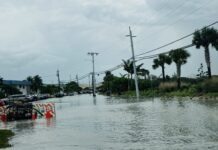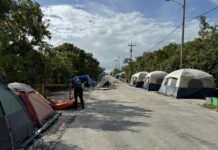
On March 8, a collection of law professors, law students and drone operators congregated at Marathon City Hall to start thinking about what the city will look like 11 years from now, 41 years from now, and 81 years from now. Using projections from the Southeast Florida Regional Compact on Climate Change, the group will consider not only how flood projections will affect Marathon, but also how best to mitigate them. The project is state mandated, known as the “Perils of Flood.”
The work is being performed through a grant with Bermello Ajamil and Partners, who are doing the mapping, and the University of Florida’s Center for Governmental Responsibility, which is providing the law expertise. Professor Thomas T. Ankersen is leading the charge and this isn’t his first rodeo.
“We’ve worked with Yankeetown and Punta Gorda,” Ankersen said, “but Marathon is certainly unique. It’s the furthest south we’ve worked and the city is so vulnerable with water on every side.”
According to Marathon Planning Director George Garrett, the mapping is almost complete, save some areas around the airport. Then experts will run a model that would reflect the Compact’s estimated sea level rise of 6 to 10 inches by 2030, or 1 to 3 feet for the year 2060.
“Of course, the further out you get, the more uncertain experts are on the actual climate change,” Ankersen said, “so I think we are going to center our estimates on a 2-foot rise by 2060. The model will show which areas of the city are most at risk as a result of additional flooding.”
The city can take the information and start thinking about some immediate solutions — like raising roads affected by nuisance flooding. Or considering what a 2-foot sea level rise would mean to infrastructure, ranging from mechanical (like a sewage plant) to natural (like an undeveloped shoreline).
“The city of Marathon looks forward to the results of the ‘Perils of Flood’ mapping and code modification effort,” Garrett said. “The data that we acquire as a result of this effort will allow the city to better plan for the future of anticipated climate change and sea level rise. This will be crucial for protecting key City infrastructure – roads, wastewater facilities, stormwater projects, etc.”
Ankersen will work with two law students on drafting the language for Marathon’s comprehensive plan, as part of the University of Florida’s special conservation clinic.
“We draft the language so Marathon can come into compliance with the state statute,” he said, adding, “it’s a fairly technical exercise for myself and my students.”
On his trip to the Keys last week, Ankersen brought along the students in his coastal law class, including 2011 Key West High School graduate Sasha Alvarenga of Big Pine Key.
“I’m just so glad that Marathon is considering this. And I think it would be really good to talk to the citizens, too,” she said. “Do they know how imminent the
danger is? Maybe they will begin to realize that if it is important enough for the city to take action, it’s something they should think of as well.”
Ankersen said one solution could be as simple as language that would require the city to create opportunities for establishing living shorelines (mangroves), and then researching ways to make that happen with tax incentives and seeking out grant opportunities.
A good flood strategy could also yield extra points under the FEMA Community Rating System that would help Marathon move to the next level of flood insurance premium reductions, Ankersen said.
“We can’t guarantee that, but that will be something that will help guide our research,” he said.
This first encounter among city staff, the law school and the mapping agency was just a “getting-to-know-you” meeting.
“The Keys people are resilient,” Ankersen said. “We need to go about making the natural and physical aspects of Marathon just as resilient.


























